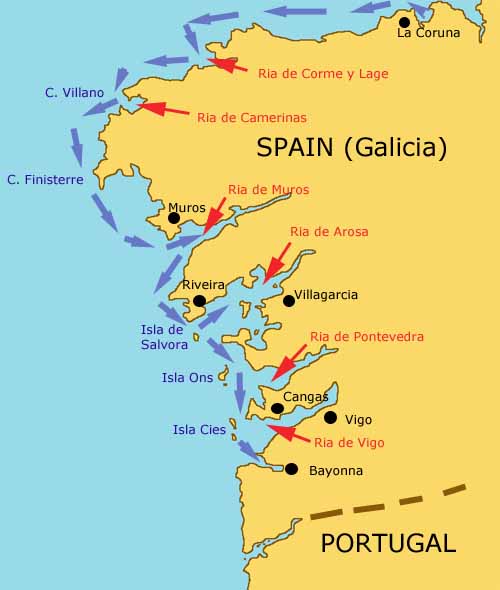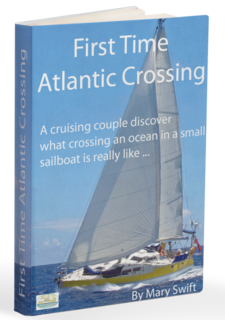- Home
- Mary's Journal
- Passagemaking
Passagemaking around
Cape Finisterre
from 'The Journal of Alacazam', by Mary Swift...
It's Friday 3rd August 2001, and it's time to continue passagemaking around the top end of Spain. Consequently, we awake with the attention of leaving La Coruña today and making for the Ria de Cormé y Lage.
Dick, my skipper and partner, makes contact with the local weather station and also goes ashore to check the forecast on the notice board in the marina office.
They're conflicting; one states a westerly F3 to F4 occasionally F5 to F6, sea state moderate and the other north-westerly F2 to F3 increasing to a F4 or F5 with high waves.
A lot of other yachts are already leaving the marina so we decide that we too will go, and start getting Alacazam ready for sailing.
 The Rias of Northwest Spain
The Rias of Northwest SpainPassagemaking: From La Coruña to Ria de Cormé y Lage
Rather than totally deflating the dinghy for stowage below as usual, we try to find a way of stowing it inflated on the foredeck. This is difficult because of the cutter rig and the baby stay. We deflate the bow only, and although not easy, manage to stow the dinghy under the staysail.
We leave La Coruña at 1200 hours wearing our foul weather gear, life jackets and harnesses, as we do not know what to expect. The wind is west-southwest, bang on the nose, force two with a big swell. We notice the yachts further out are motoring but we are doing 3 to 4 knots so we keep sailing.
The wind freshens to F4 to F5 and the sea is quite choppy. The mobile phone rings and it's our sailmaker; it's is lovely to speak to him but we have to cut the conversation short because, as we explain to him, the wind is freshening again and we are about to put a reef in his splendid mainsail, much improved by the addition of two full-length battens.
The waves are short and sharp and we are beating into them. I helm while Dick puts in the reef; we also put a roll in the yankee and Alacazam immediately becomes more upright.
It is now blowing a F6 and although uncomfortable it is OK. I remark how dry the yacht stays and just as I go below to check that everything is still ship shape, we go through a wave instead of over it and Dick is drenched.
He just recovers when we hit another one and he is drenched again. I find this hilarious of course, as much to his chagrin I am totally dry.
It will soon be time to tack onto the more comfortable tack. We can hardly believe it but the wind is starting to veer, making our present tack more comfortable, and we will be tacking back into the waves. Not only that, but the wind drops to a F2 on a lumpy sea.
It is now 1730 hours, but at least we are sailing upright and I am able to prepare a bite to eat and make a cup of tea. We eat a Spanish dessert called 'Pastel de Queso' and although the basis is cheese it tastes very similar to the 'Breton Far' we ate in Camaret-sur-Mer.
The sea settles down, although there is still a big swell, as we are closer to land and sheltered by the Islas Sisargas (an island that is a seabird sanctuary).
I find the swaying motion soporific and manage to doze off with a full mug of tea still in my hand - not to be recommended.
The coastline is very rugged and we can see a number of wind farms on top of the cliffs. The wind dies away as we pass the islands and we have to motor. There is a large swell and it is most uncomfortable sailing with the autopilot trying to steer the boat, so Dick drops the mainsail and I helm the rest of the way, steering around the swell, which is still coming from the northwest. We are close to the Ria de Cormé y Lage and with the swell in this direction, we believe that anchoring off Cormé (on the north of the Ria as you enter it) will offer more shelter, and decide to visit there first.
This has not been the most pleasant day's sailing but just as we turn towards Cormé I spot a dolphin, then two and three racing towards us. They are soon joined by five more and we are treated to a wonderful spectacle of acrobatics as they escort us the rest of the way to the breakwater. Our spirits are lifted. These are larger dolphins than the ones we have seen previously; similar fins, tails and noses but totally grey.
We anchor to the east of the town where there are five other yachts already anchored, near some viveros (large rafts with ropes hanging from them where mussels grow) and close to the beach. It is so quiet and peaceful here; we eat our dinner by candlelight and listen to CD's - 'Yentle' by Barbra Streisand and classical music.
Our only disappointment is that the expensive (well, for us!) wine we had bought was not nearly as good as we thought it would be. Dick goes to bed but I cannot resist sitting in the cockpit for a while just enjoying the tranquillity before joining him. The fishing boats entering and leaving the harbour wake him through the night, but nothing disturbs me.
Passagemaking: From Ria de Cormé y Lage to Ria de Camariñas
Monday 06 August 2001
Dick is glad to be leaving Lage; the swell during the night had made the anchorage uncomfortable and the crash of the waves on the beach had unsettled him and woken him a few times.
We motor out of the Ria; it is a very grey day with clouds as far as the eye can see and the sea is mirroring the greyness of the sky, but there is no wind. The coastline is very rugged and in this light appears quite dramatic.
We're now getting used to the large swell; it is not uncomfortable and I helm for the four hours it takes to reach the fishing village of Camariñas in the 'Ria de Camariñas'.
We pass a number of fishing boats both large and small and wonder at the courage of the fishermen in the small boats that are so difficult to see in the swell. We can see the point ahead where we turn into the Ria and it seems to take ages to reach it. Once we are in the Ria the swell is behind us and it is fun surfing down the waves. There are some hazards to avoid but Dick has no problem negotiating them and I helm the course he sets me.
The sun breaks through the cloud and within minutes all the clouds have disappeared. This Ria is slightly bigger; prettier and softer. There are mountains in the background but there are more pastureland and yellow beaches everywhere.
Camariñas is a sheltered harbour and we anchor just off the yacht club marina. The sky is now a brilliant blue and it is warm, almost hot. We are very aware that we should be south of the Portuguese coast before the September gales start and wish that we had left the UK earlier so we could have spent more time in the Rias.
Next: At Anchor and Ashore in The Rias Altas
or, jump to
Passagemaking through the Rias Bajas
Recent Articles
-
Wauquiez Gladiateur 33 for Sale
Apr 10, 24 05:40 AM
'Kesh', my Wauquiez Gladiateur 33 is only for sale because we've decided to go for a larger sailboat. She currently berthed in Florida, USA. -
'Cabo Frio', a Catalina Morgan 43 for sale
Apr 01, 24 08:35 AM
This Catalina Morgan 43 is for sale at a very reasonable price. She offers up to 7 berths in 2 cabins + saloon. There is full 6'5" standing headroom and good ventilation throughout. -
Live Aboard Boats For Sale
Mar 30, 24 07:02 PM
Ready to live the dream? Then browsing through this listing of live aboard boats for sale might just get you on your way...













